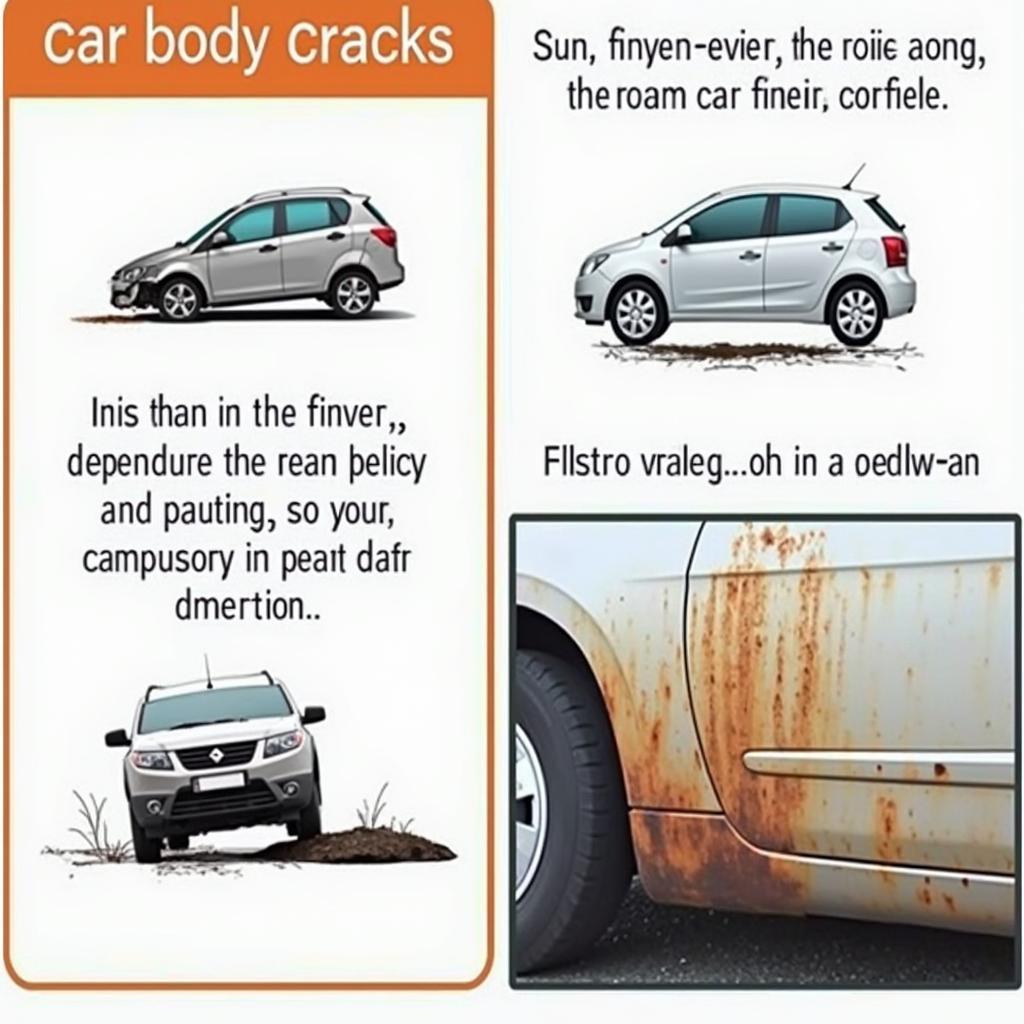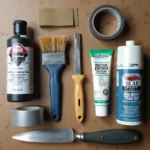Car body cracks are an unsightly nuisance that can affect any vehicle owner. Whether it’s a minor hairline fracture or a large, noticeable crack, these blemishes can detract from your car’s appearance and potentially compromise its structural integrity. Understanding the causes, repair options, and preventative measures for car body cracks is essential for maintaining your vehicle’s value and safety.
What Causes Car Body Cracks?
Car body cracks can stem from various factors, ranging from minor incidents to more severe collisions. Here are some common culprits:
- Minor Accidents: Even low-speed impacts, such as bumping into a curb or another vehicle in a parking lot, can generate enough force to crack your car’s bodywork, especially in vulnerable areas like bumpers and fenders.
- Stress Fatigue: Over time, the constant vibrations and stresses from driving on uneven roads, potholes, and speed bumps can weaken your car’s body panels, making them susceptible to cracking.
- Weather Conditions: Extreme temperature fluctuations, prolonged exposure to sunlight, and harsh weather elements like hail and ice can cause your car’s paint to fade, become brittle, and eventually crack, exposing the underlying bodywork to potential damage.
- Poor Repair Work: Improperly repaired collision damage or shoddy aftermarket modifications can create weak points in your car’s body, increasing the likelihood of cracks developing.
- Rust and Corrosion: Rust weakens the metal of your car’s body, making it more prone to cracking, especially in areas where paint chips or scratches expose the bare metal to moisture and air.
Different Types of Car Body Cracks
Not all car body cracks are created equal. They can vary in severity, location, and the materials affected. Understanding these distinctions can help you determine the appropriate repair approach.
Paint Cracks
These are the most superficial type of crack, affecting only the top layer of paint. They often appear as hairline fractures or spiderweb-like patterns, typically caused by UV damage, improper paint application, or aging.
Clear Coat Cracks
Similar to paint cracks, clear coat cracks are confined to the protective clear coat layer applied over the paint. These cracks usually appear as fine lines and can be caused by UV damage, harsh chemicals, or improper washing techniques.
Fiberglass Cracks
Fiberglass is a common material used for car bumpers, fenders, and body kits. Fiberglass cracks can range from small spider cracks to larger, more structural damage, often resulting from impacts or stress fatigue.
Metal Cracks
Metal cracks are the most serious type, indicating potential structural damage to the car’s frame or body panels. These cracks can occur due to major collisions, severe rust, or improper repair work.
Car Body Crack Repair: DIY vs. Professional
Deciding whether to tackle a car body crack repair yourself or seek professional help depends on several factors, including the severity of the crack, your DIY skills and experience, and your budget.
DIY Car Body Crack Repair
For minor paint cracks or clear coat cracks, a DIY approach might be feasible. Numerous car repair kits and online tutorials can guide you through the process of sanding, filling, priming, and repainting the affected area. However, achieving a seamless and professional-looking finish requires patience, attention to detail, and the right tools and materials.
Professional Car Body Crack Repair
For larger cracks, structural damage, or if you lack the time, skills, or confidence for a DIY repair, seeking professional help is highly recommended. Experienced auto body technicians have the expertise, equipment, and resources to assess the damage accurately and perform the necessary repairs to restore your car’s structural integrity and aesthetic appeal.
car body repairs by bromhams bodyworks ltd derby provide top-notch car body repair services, ensuring high-quality workmanship and customer satisfaction.
Preventing Car Body Cracks: Proactive Measures
While not all car body cracks are preventable, taking proactive steps can significantly minimize their occurrence and protect your vehicle’s exterior.
- Regular Washing and Waxing: Frequent washing removes dirt, grime, and contaminants that can degrade your car’s paint, while waxing provides a protective layer against UV rays, oxidation, and minor scratches.
- Timely Repairs: Address minor paint chips, scratches, and dents promptly to prevent them from worsening and potentially exposing the underlying bodywork to damage.
- Careful Driving: Avoid driving over potholes, curbs, and speed bumps at high speeds. Be mindful of your surroundings and park in well-lit areas to minimize the risk of minor collisions.
- Rust Prevention: Regularly inspect your car for signs of rust, especially in areas prone to moisture accumulation. Treat any rust spots promptly to prevent further spread and potential structural damage.
Conclusion
Car body cracks, while common, shouldn’t be ignored. Understanding their causes, types, and repair options empowers you to make informed decisions about maintaining your vehicle’s appearance and safety. While minor cracks might be manageable with DIY solutions, seeking professional help ensures a lasting and high-quality repair for more severe damage. By adopting preventive measures and addressing issues promptly, you can keep your car looking its best and protect your investment for years to come.
FAQ
Q: How much does it cost to repair a crack in a car body?
A: The cost of car body crack repair varies widely depending on the severity, location, and type of crack, as well as the make and model of your car. Minor paint crack repairs can range from a few hundred dollars for DIY solutions to a few thousand dollars for professional repairs. Larger cracks or structural damage can cost significantly more.
Q: Can a car body crack be repaired without repainting the entire panel?
A: In some cases, minor cracks might be repairable using techniques like spot painting or blending, where only the affected area is repainted. However, achieving a seamless match with the surrounding paint can be challenging, and a professional assessment is crucial to determine the best approach.
Q: How long does it take to repair a car body crack?
A: The repair time depends on the complexity of the damage and the chosen repair method. Minor repairs might take a few hours to a day, while more extensive damage could require several days or even weeks to complete.
Q: Can I still drive my car with a crack in the body?
A: While driving with a minor paint crack might not pose an immediate safety hazard, it’s essential to assess the severity and location of the crack. Larger cracks or structural damage can compromise your car’s safety and should be addressed promptly by a professional.
Q: Does car insurance cover car body crack repairs?
A: Coverage for car body crack repairs depends on your specific insurance policy and the cause of the damage. Comprehensive coverage typically covers damage caused by events like collisions, vandalism, and weather-related incidents.
Have more questions? Check out these related articles:
car body repair derby provides valuable insights into various aspects of car body repair.
Need immediate assistance? Contact our 24/7 support team via WhatsApp: +1(641)206-8880, or Email: [email protected].



